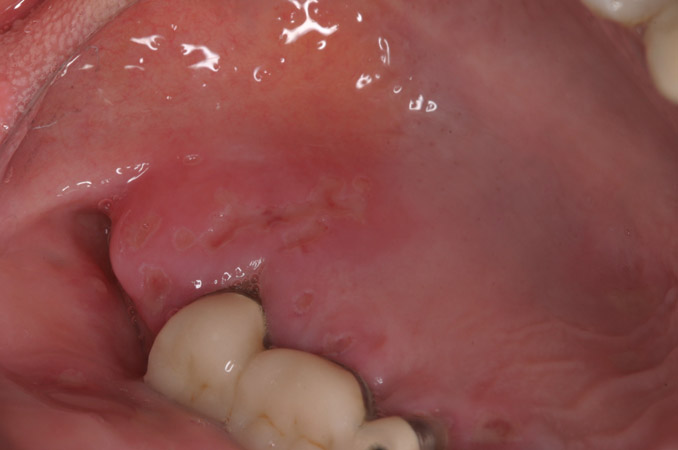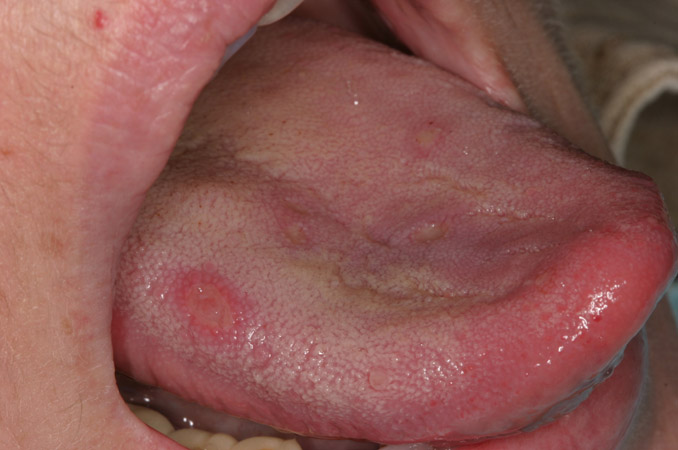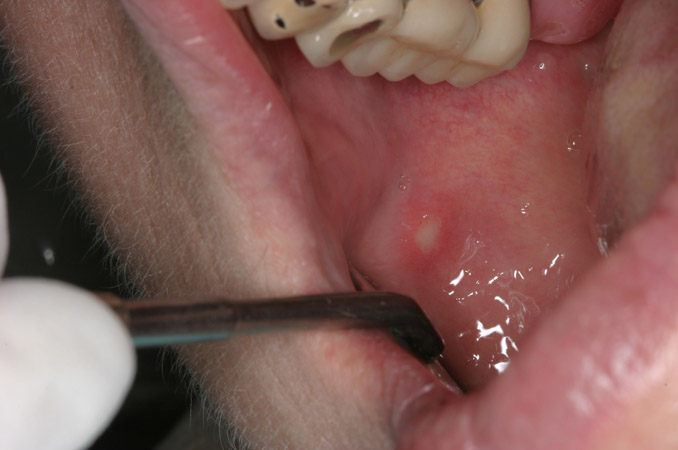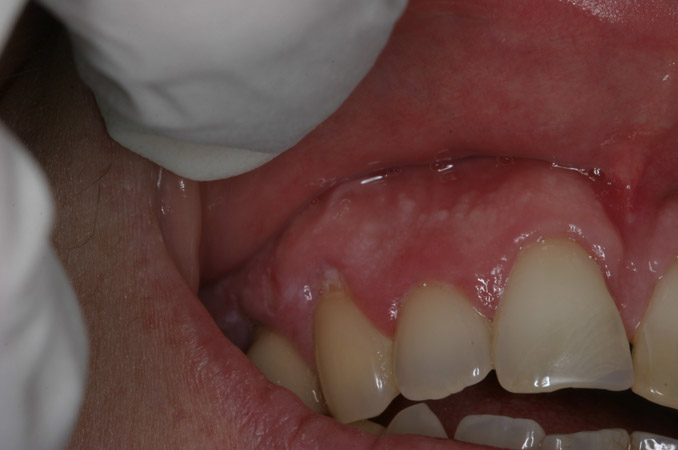Forums › Laser Treatment Tips and Techniques › Soft Tissue Procedures › Tx of Herpetic Lesion
- This topic is empty.
-
AuthorPosts
-
Janet CenturySpectatorNo photos, but I used the diode for the first time to treat an aphthous ulcer – on my significant other / guinea pig. Got to him on the first day and the next day it was GONE. I think this will be a great service to the patients, especially on the little kids who absolutely stop eating when they get one of these.
Glenn van AsSpectatorHi Janet……..use both lasers ( the diode works deeper and the erbium more superficial) and I would use the erbium first which is less sensitive and then go deeper but lets see what others suggest.
glenn
Janet CenturySpectatorThanks Glenn. Today (before reading your post) I did my first herpetic lesion. Patient came in for bonding and had a very painful cold sore on the lower lip. I grabbed the erbium (because it was in the room – glad to see you recommend that first). I used it set at 10 Hz, 35mJ. She felt it a little from time to time, but I would just back off and then go closer.
Afterwards, all she could say was “Oh my God, Oh my God”. Her pain was completely gone. I’ll call her tomorrow and see how it’s going.
On the human side, I was completely jazzed to help someone like this and feel so appreciated. On the business end, it kept a 蹜 appointment from cancelling.
Having fun,
Janet
Robert GreggParticipantHi Ron,
This is a GREAT question!
I know from where and whence the phrase “use the least amount of energy to reach the treatment objective” came from.
It came from the early days of pulsed Nd:YAG clinical laser use (1990) where we had no idea of light dosimetry in tissues for anything. So the idea was advanced that the “least” amount of energy to achieve what we “thought” was the treatment objective was coined and advanced–chiefly by Professor Doctor Joel White at UCSF and his like-minded laser dentist colleagues in the ALD with Educator Status (which I have as well but don’t agree on this point).
For new laser users, this laser Rule of Thumb is a “nice” admonition…but not necessarily safe, accurate, efficient, nor optimally therapeutic. Sure, you can see some “nice” results with that Rule of Thumb, but we can be more predictable and knowledgeable about the treatment results than that!
In order for that laser “Rule of Thumb” to apply, one needs to FIRST define what the Treatment Objective is.
In herpetic lesions, the T.O. might be:
a. ease the itching and pain
b. reduce swelling
c. reduce inflammationOK STOP! Then follow the protocol you used.
If you also want to:
d. keep the itching, swelling, inflammation and pain from returning
e. kill the maximum amount of live virus
f. dentature pathologic proteins
g. inactivate epithelial tags necessary for viral replication
h. a. b. c.
i. d. e. f. g. h. i
j All the above
k. None of the aboveIf “j” is your answer, then a new treatment protocol–and light and time intensity–is indicated…..
In our training we advocate that the treatment objective is to put the OPTIMAL, not the LEAST nor the MOST amount of energy to reach the treatment objective, such that no extended lateral tissue injury ocurrs. Sometimes that means our powers are VERY high, but our tissue interactions times are very short. Sometimes it means our treatment times are longer, and our energy and intensity are high, but our effects are diffuse, wide and deep. Remember your hard tissue analgesia settings.
Herpetic lesions require a light intensity sufficient to have the live virus killed, the inflammatory proteins denatured, and the epithelial tags inactivated (so no new lesions recur in that same treatment site).
One more thought:
The light intensity (light dose) that you are able to put in using EMLA is actually MORE intense and “harmful” than a defocused application which uses more time and less energy to the surface and diffuses deeper into tissue (like you do when you use your erbiums to create analgesia in teeth by “painting” the tooth at 6 watts and at distance).
Also, local anesthetics penetrate skin and mucosa and enter the blood stream in high concentrations. I’m not shy about using it, but for the sake of the “safety” arguement, there is a higher chance of anesthetic toxicity with topical versus local. So I don’t see the safety aspect of using ELMA and close proximity irradiation from that aspect.
OK, how do you caluculate?
By not using the ELMA and monitoring the patient’s response. It takes about 30-60 seconds for the lesion to become numb for the patient, then another 3-4 minutes per centimeter to complete the treatment. (Pssst! Knowing that your lasers create analgeisa in pulp tissue, why not try it for soft tissue boo boos?!)
It also helps to know the energy at the fiber tip and have a power meter and joule counter on the laser–but that would make it too easy!!:biggrin:
Thanks for the question!
Have a great weekend!
Bob
(Edited by Robert Gregg at 7:58 pm on Jan. 10, 2003)
AnonymousGuestQUOTEQuote: from Robert Gregg on 7:47 pm on Jan. 10, 2003In our training we advocate that the treatment objective is to put the OPTIMAL, not the LEAST nor the MOST amount of energy to reach the treatment objective, such that no extended lateral tissue injury ocurrs. Sometimes that means our powers are VERY high, but our tissue interactions times are very short. Sometimes it means our treatment times are longer, and our energy and intensity are high, but our effects are diffuse, wide and deep. Remember your hard tissue analgesia settings.
(Edited by Robert Gregg at 7:58 pm on Jan. 10, 2003)
Thanks for the response Bob.
I hope after this post you’re not sorry you responded, because now I have more questions 😉
How do I figure out the optimal energy per procedure? I see what you’re saying with the herpetic lesion tx and why you’d want to accomplish e,f & g, but how do would know before you did the tx, that the longer defocused tx results in e,f & g and not deeper more intense effect because of longer absorption time?
Is this because of the shape of the ‘irradiated volume’ of focused vs. defocused?
If I understand desensitization, the defocused time is to get deeper penetration and thus anesthesia effect and then when you move into focus you are actually trying to affect the surface. Then it would seem to follow that, with the herpetic lesion tx you outlined the primary objective is to affect the deeper tisue with a minor emphasis on the surface, correct? and likewise with a fibroma removal the primary objective , once anesthetic effect is in place, is to focus and keep the energy more at the surface to cut, correct?
So if the focus vs. defocused determines the primary location of the effect (correct?) How do you determine time? Patient response (pain/no pain, tissue color change,etc)?
When I first tried amalgam removal I thought about Mark being able to do crown preps w/o anesthesia and wondered if the same settings would allow enough anesthesia effect to use the high speed to remove amalgam – fortunately it worked, is this the kind of adaptation you need to do to figure these optimal settings out? or is there a ‘rule of thumb’?
Thanks for your willingness to share your knowledge and experience. Once again you’ve helped me take some steps forward in my lasing,
Robert Gregg DDSSpectatorGood Morning Ron,
Why do I feel like a fish being reeled in?
To answer your questions:
Measurements, histology, research, study, experience.
Yes.
Correct.
Ummm….correct.
(correct)
Right!
Absolutely.
By George, I think you’ve got it!
:biggrin:
Bob
Can I come back later and place the quotes where they belong for the answers?
Rick Williams DDSSpectator[img]https://www.laserdentistryforum.com/attachments/upload/AcuteGingivoStomatitis2.JPG[/img]
[img]https://www.laserdentistryforum.com/attachments/upload/AcuteGingivoStomatitis3.JPG[/img]
Hi Bob, Janet, Glen, Ron, Allen, et all;
I was reading the posts & herpetic lesions caught my eye. For a long time I’ve been using free running Nd:YAG for pain management. Bob is “right on” in his assesment of LLLT vs. HLLT – they both work non-contact, HLLT much quicker. [Get him to tell you the whole story on his tendon surgery – amazing.]
The idea is to get the energy (whatever wavelength) into the lesions. It sounds like we use virtually the same tech. Patients don’t care how it works, just that the pain relief is immediate and profound. I guess I feel the same way. An Md referred this patient, said it was Acute gingivostomatitis. One tx. non-contact Nd:YAG with immediate pain relief & 2nd slide 1 week later. I’m getting the same results with HSV & ZVZ lesions as well.
The only thing I can report about accelerated healing is that, whether it’s prodromal or a mature vessicular lesion, it’s my experience they usually dry up in about a week. But what’s clinically significant to the patient is the pain relief. I’ve got more before-after slides I’d be happy to share if your interested.
Let me know if the pictures came through? I’ll put my mugshot on future posts soon as I figure it out…
Rick
p.s. (?) how come we get only 300kb max.?
greg holmSpectatorThanks to all for their posts.
This is a somewhat off subject question. What about using the delight or waterlase to remove some of those ‘age’ or ‘sun’ spots we seem to get the older we are? (This is not a question for tx of pts but of myself)?
Another question closer to topic. What is your relative fee for tx of apthous or herpes lesions?
Greg
Robert GreggParticipantGreg,
Ron is 100% correct.
QUOTEAs far as age or sun spots I think you’d want to use a laser that targets pigment rather than h20.Pulsed Nd:YAG’s take those off nicely,and w/o hurtin’. Right Rick?!
Bob
drTommyUSpectatorHi everyone. A first timer here.
How do you guys bill such tx, apthous or herpetic lesion, to the ins. ? Have you had any rejections ? Thanks
Robert GreggParticipantHi TU,
I just bill the patient out as an office visit, usually. Since it is a small fee of say โ-75 (more if more involved), they often pay on the spot, and insurance is a secondary issue to the treatment need.
But we make sure we make to FA’s before we begin treatment. That’s always the part where disciplpine with yourself and the front desk is needed to get the FA’s agreed to, since removing and/or treating those lesions are relatively quick and painless.
That’s how we handle it, and try to get people to save their benefits for other needed stuff, or tell them it is a non-reimbursable procedure, and they will often elect to pay cash. Nice way to save on insurance headaches.
But I haven’t looked at the new CDT-4.
Bob
RodSpectatorLotsa great stuff on this thread. I’d just like to comment that I also use both the erbium and diode on both herpetic and apthous ulcer lesions. Different depths of penetration and surface effect.
They work wonders.
Rod
jetsfanSpectatorThis woman,in a lot of pain, was sent to me by her physician. He believed this to be Coxsackie Virus. She had lesions on hard palate, dorsum of tongue, attached gingiva(so far sounds like herpes) and buccal mucosa. Would not expect buccal mucosa with herpes. Lesions treated with waterlase at .25W 11%A no water. Patient was called and felt great.
The point of the post was to mention that our medical colleagues are slowy becoming aware of what we can do.




p.s. How about those JETS!
N8RVSpectatorI posted this on DT (mainly because I enjoy the abuse) and thought I’d add it to this thread …
In the Standard Certification Course given by Hoya, we were introduced to treating RAU and herpetic lesions similarly, the only difference being that we were instructed to use viral-filtering masks when ablating herpes lesions to avoid inhaling the infected laser plume.
Another poster on DT questioned the wisdom of this procedure, fearing that we’re spreading viruses all over our offices without adequate protection for ourselves and our patients.
Got me thinking. Indeed, even if we use the high-volume vacuum to suck up the plume, where are the viruses going? Aren’t they being spread throughout our vacuum system? Can any un-sucked plume REALLY spread infection elsewhere in our offices, threatening other staff and patients?
Since laser treatments are in their infancy, nearly everything we do is in someway still being explored. Have we delved headlong into the techniques without considering the adjunctive ramifications of our treatment?
On the other hand, are these questions overboard? Is this a case of worrying about a problem that doesn’t exist? The last thing we need is knee-jerk overreaction to an unrealistic fear (can you say, “OSHA”?)
Knowing nothing about virology and even less about how viruses might be spread through the laser plume, I’m adding this in hopes that someone out there may possess authoritative knowledge about this topic and can offer some guidance.
Any takers?
— Don
Graeme MilicichSpectatorRon
Just spotted this thread.
As a rule of thumb when explaining to patients what they can expect when treating Herpes with the Waterlase, if the lesion is prodromal, I tell them with reasonable certainty that they won’t get a cold sore.I paint the area without topical 0.25W, and map out the outline then continue until I have joined all the dots and have a totally white surface. A bit if water or vaseline makes it go away. I deliberately wipe off any ointment the patient may ahve applied so I can see what is happening and use the appearance of the white spots as the indicator I am at the right focal distance. By not using topical, you can’t deliver too much energy to the site and cause negative damage to the tissue, the patient won’t let you!!!
If there is any vescicular formation, I explain to the patient that there is already some tissue damage. The laser will stop the progression of the lesion from this point in time, but the damaged, delaminated epithelial tissue still has to heal.
Make sure you define the absolute extremities of the lesion, plus a bit more. Nothing worse that having the patient return with something developing just outside where you treated!!!
If the vescicles have ruptured, the mesage is the same. Healing of the damage will take about 7 days, but the virus propagation has been halted and healing will be enhanced by LLLT.
I actually advertized this Tx in my practice newsletter. I pointed out that the ideal time is to treat cold sores when they are in the prodromal tingling phase. We promise to see them within 2 hours of them phoning. It is only 2-3 minutes to treat one in between patients. ๛. Most think this is a great investment to avoid two weeks of hassle (and not being able to kiss the girlfriend or boyfriend!).
Pre-educating your patients makes this a very successful service.Cheers
-
AuthorPosts
